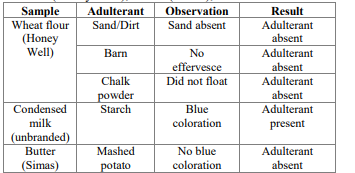Experimental Authentication of Common Nigerian Consumer Food Products Reveals Absence of Food Fraud in Branded Products
Keywords:
Adulteration, Fraud, Condensed Milk, Wheat flour, ButterAbstract
Food adulteration is the act of addition or removal of valuable food components or substitution of these valuable ingredients with relatively cheaper substances for unfair economic gain. Adulterated foods affect consumers in different ways, such as lack of the expected food nutrients, being unsafe and it constitutes economic loss to the consumers. Several foods are susceptible to adulteration in Nigeria and the world at large, including milk, meat, wheat flour, honey, butter, juices, and sugar. In this study, chemical methods were used to determine the presence of adulterants in wheat flour (Honey Well brand), condensed milk (unbranded) and butter (Simas brand) consumed in Nigeria. The tests assayed for the presence of starch in milk, sand/ dirt, barn and chalk powder in wheat flour, and potato in butter. The results showed that none of the branded products were adulterated, but condensed milk (unbranded) showed the presence of starch. This is an indication that enforcement of compliance by the National Agency for Food Drug Administration and Control (NAFDAC) in the food industries is impactful, and also there is corresponding compliance.
References
A.M. Amin, S.R. Avik, S. Ahsan, L.H. Khan, “Eating Away our Health” Star Weekend Mag., The Daily Star, pp.8–13, 2004.
S. Awasthi, K. Jain, A. Das, R. Alam, G. Surti, N. Kishan, “Analysis of Food Quality and Food Adulterants from Different Departmental and Local Grocery Stores by Qualitative Analysis for Food Safety,” IOSR Journal of Environmental Science Toxicology and Food Technology, Vol. 8, Issue 2, pp.22-26, 2014.
H. Ayalew, A. Birhanu, B. Asrade, “Review on Food Safety System: Ethiopian Perspective,” Africa Journal of Food Science, Vol. 7, Issue 12, pp.431-440, 2013.
M. Banti, “Food Adulteration and Some Methods of Detection, Review,” International Journal of Research Studies in Science, Engineering and Technology, Vol. 7, Issue 4, pp.9-19, 2020.
S. Banu, A. Hakan, B. Gonca, H.B. Ismail, “Coffee arabica Adulteration: Detection of Wheat, Corn and Chickpea,” Food Chemistry; Vol. 264, pp.142 – 148, 2018
J.C. Bartlet, D.G. Chapman, “Butter Adulteration, Detection of Hydrogenated Fats in Butter Fat by Measurement of cis-trans Conjugated Unsaturation,” Journal of Agricultural and Food Chemistry, Vol. 9, Issue 1 pp.50-5, 1961
W. Billah, Kaporer Lal Ronge Lal Chal, “Red Rice with Red Textile Die). The Daily Prothom Alo, pp.3, 2007.
W. Fischer, B. Schilter, A. Tritscher, R. Stadler, “Contaminants of Milk and Dairy Products: Contamination Resulting from Farm and Dairy Practices,” Encyclopedia of Dairy Sciences, Vol. 2, pp.887–97, 2011.
M.M. Hossain, V. Heinonen, K.M.Z. Islam, “Consumption of Foods and Foodstuffs Processed with Hazardous Chemicals: a Case Study of Bangladesh,” International Journal of Consumer Studies, Vol. 32, pp.588–595, 2008
O. O. Ifatimehin, F. Ujoh, P.S. Eneche, “Attributes of Topographic Mapping of a Fast-Urbanizing Area in Nigeria, Using Remote Sensing and GIS,” Journal of Scientific Research and Reports, pp.170-184, 2014.
J. Moudrý, K.F. Mendes, J. Bernas, R.T. da Silva, R.N. de Sousa, “Multifunctionality and Impacts of Organic and Conventional Agriculture,” BoD – Books on Demand Publishers, Germany, pp.75, 2020.
T. Jolanta, “Rapid Quantitative Determination of Butter Adulteration with Palm Oil Using the DSC Technique,” Food Control, Vol. 60, pp.629-635, 2016.
M. J. Manasha, “Food Adulteration and its Problems (Intentional, Accidental and Natural Food Adulteration),” International Journal of Research in Finance & Marketing, Vol. 6 Issue 4, pp.131-140, 2016.
Z. Mansuri, “Study of Adulterants in Foods,” Delhi, India, 2011.
J.C. Moore, J. Spink, M. Lipp, “Development and Application of a Database of Food Ingredient Fraud and Economically Motivated Adulteration from 1980 to 2010,” Journal of Food Science, Vol. 77, pp.108–16, 2012.
A. Rao, S. Tahura, S. Iffath, “A Study on Adulteration of Milk, Wheat Flour, Red Chilli Powder and Salt from Different Zones of GHMC, Hyderabad,” International Journal of Science and Research, Vol. 8, Issue 7, pp.56 – 59, 2019.
S. Rashid, “Vejale Chheye Gechhe Desh (the Country has been Flooded with Adulterated Foods),” The Daily Janakantha, Bangladesh, pp. 1 and 11, 2007
P. Singh, N. Gandhi, “Milk Preservatives and Adulterants: Processing, Regulatory and Safety Issues,” Food Reviews International, Vol. 31, Issue 3, pp.236–261, 2015
H. Singuluri, M. Sukumaran, “Milk adulteration in Hyderabad, India – a Comparative Study on the Levels of Different Adulterants Present in Milk. Journal of Chromatography and Separation Techniques. Vol. 5, pp.212, 2014.
S. Wen-Hao, S. Da-Wen, “Evaluation of Spectral Imaging for Inspection of Adulterants in Terms of Common Wheat Flour, Cassava Flour and Corn Flour in Organic Avatar Wheat (Triticum spp.) Flour,” Journal of Food Engineering, Vol. 200, pp.59 – 69. 2016
W.Terouzi, F. Kzaiber, A. Gorfti, A. Oussama, “Application of Multivariate Analysis to Predict Adulteration of Moroccan Traditional Butter by Mashed Potatoes,” International Journal of Engineering Research and Allied Sciences (IJERAS), Vol. 01, Issue 10, pp.8 – 12, 2017.
Prothom Alo. “Chemical Die Aam Pakanor Ovijoge Chhoijoner Saja (Six were Punished for Ripening Mango using Chemicals), Prothom Alo, pp. 19–20, 2005
H. Ullah, “Adulterated Food: Thought From an Expatriate,” The Daily Star, Bangladesh, 2005.
M. Adeyeye, “Kano Food Poisoning: NAFDAC Apprehends Merchants of Dangerous Chemicals”, Vanguard Newspaper, Nigeria, 2021.
FAO. “Intention, detection and management. Food safety technical toolkit for Asia and the Pacific”. Food fraud –No. 5, Pp 6. 2021
Xiong, X., Guardone, L., Cornax, M.J., Tinacci, L., Guidi, A., Gianfaldoni, D. & Armani, A. “DNA barcoding reveals substitution of sablefish (Anoplopoma fimbria) with Patagonian and Antarctic toothfish (Dissostichus eleginoides and Dissostichus mawsoni) in online market in China: How mislabeling opens door to IUU fishing”. Food Control, Vol 70, pp. 380–391. 2016

Downloads
Published
How to Cite
Issue
Section
License

This work is licensed under a Creative Commons Attribution 4.0 International License.
Authors contributing to this journal agree to publish their articles under the Creative Commons Attribution 4.0 International License, allowing third parties to share their work (copy, distribute, transmit) and to adapt it, under the condition that the authors are given credit and that in the event of reuse or distribution, the terms of this license are made clear.





